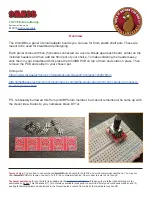
Introduction
The 40T has a rugged, waterproof stainless steel design for ease of installation. The
lightweight sensor elements are designed so that no mechanical clamping is
required. Because of this, the 40T is ready to record ground movements as soon as
you provide it with power. In addition, the sensor does not have to be levelled or
centred as long as the base is within 3° of horizontal. For the best results, however,
you should install where possible on a hard, near-horizontal surface well coupled to
the bedrock.
Each seismometer is delivered with a detailed calibration sheet showing its serial
number, measured frequency response in both the long period and the short period
sections of the seismic spectrum, sensor DC calibration levels, and the transfer
function in poles/zeros notation.
2.1
Response options
The standard frequency response for a 40T is flat to velocity from 60 seconds
(0.017 Hz) to 100 Hertz.
Standard alternative frequency response options are:
•
flat to velocity from 30 seconds (0.03 Hz) to 100 Hertz
•
flat to velocity from 1 second (1 Hz) to 100 Hertz
Other frequency response options have been manufactured in the past. Please
contact us if you require a difference frequency response.
If you do not require high-frequency data, a low-pass filter may be installed at a
frequency (below 50 Hz) that you specify.
Standard 40T instruments output signals representing ground velocity on three
pairs of balanced differential lines. An option is available which provides a second,
parallel set of outputs at higher gain. The high-gain outputs have a sensitivity
nominally 10 times higher than the standard (low-gain) outputs.
6
Issue F - June 2019







































